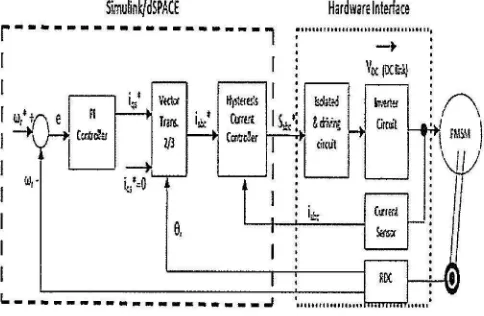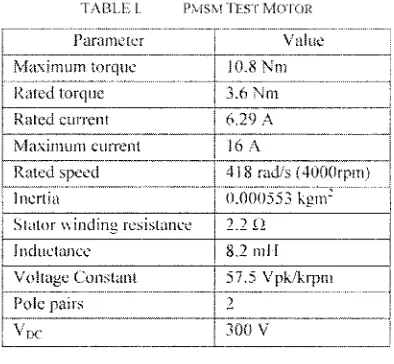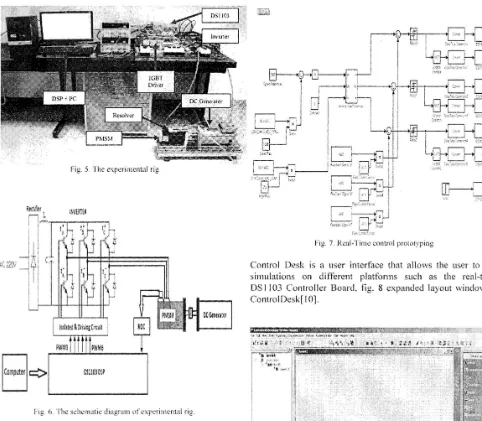VECTOR CONTROL DRIVE OF PERMANENT MAGNET
SYNCHRONOUS MOTOR BASED dSPACE DS1103 IMPLEMENTATION
CHEOK YONG SENG
PROFESOR MADYA DR ZULKIFILIE BIN IBRAHIM
Vector Control Drive of Permanent Magnet
Synchronous Motor Based
dSPACE DS1103 Implementation
Cheok Yong Seng and Zulkifilie Ibrahim
Abstract-This paper presented a vector controlled drives of permanent Magnet Synchronous Motor (PMSM) by using Proportional-Integral (Pl) Speed controller based dSPACE implementation. The concept of vector control is applied to PMSM to obtain linear dynamics similar to that of a DC motor. The model consist of two control loops, hysteresis current controller is used for inner loop current control and PI controller for outer loop speed control. PI speed controller selected due to simplicity compare to fuzzy, neutral etc. to make sure dSPACE DS1103 successfully implemented. The PMSM vector control algorithm for a theoretical basic has been verified by
experimental results and created a rapid control prototype environment by using MATLAB/ Simulink and the DS1103 DSP ofdSPACE.
flu/ex Terms--PMSM, Vector Control, Simulink, OSI 103, Proportional-Integral
I. INTRODUCTION
In recent years, with the rapid development of electric power electronic Permanent magnet synchronous motors are progressively replacing de motors in high-performance applications like aerospace actuators, robotics and industrial applications because of precision, efficient, larger torque inertia ratio and power density when compared to the induction motor for the same output capacity. The PMSM is smaller in size and lower in weight that makes it preferable for certain high performance applications [I). Vector control is normally used in ac machines to convert them, performance wise, into equivalent separately excited de machines.
The PMSM is a rotating electric machine where the stator is a classic three phase stator like that of an induction motor and the rotor has surface-mounted permanent magnets. In this respect, the PMSM is equivalent to an induction motor where the air gap magnetic field is produced by a permanent magnet. The use of a permanent magnet to generate a substantial air gap magnetic flux makes it possible to design highly efficient PMSM. Many intelligent control techniques, such as fuzzy control, neural networks control, adaptive fuzzy control, etc., have been developed and applied to the precision position
Cheak Yong Seng is MSc student in Faculty of Electrical Engineering, University Tcknikal Malaysia, Malacca. (e-mail: [email protected])
Zulkifilie Ibrahim is with Faculty of Electrical Engineering, Universiti Teknikal Malaysia Melaka, Malaysia. (e·mail: [email protected]).
control of servo motor drives to obtain high operating performance. A high performance motor control system should have a fast dynamic response in adjusting its control parameters so that the motor outputs affected by the disturbances can recover to their original status as soon as possible [2].
In [2], with the rapid development in microprocessor, the high performance DSP chip becomes a popular research on digital control for ac drives due to their high-speed performance, simple circuitry, on-chip peripherals of a micro-controller into a single chip solution. The experimental results demonstrate that in step command response and frequency command response, the rotor position of PMSM can fast track the prescribed dynamic response well. However, the whole system required a complicated operation of the proposed control algorithm, programming and difficulty on control design modification.
In [3], a vector control implemented on PMSM in real time with ADMC-401 motor control DSP. The time varying abc currents are made stationary using Reverse Park Transformation, to simplify the calculation of PI controller's constants. This method enables the operation of the drive at zero direct axis stator current. Therefore, with minimum armature current can obtain maximum torque per ampere and maximum efficiency. The performance of vector control is satisfactory for achieving fast reversal of PMSM even at very high speed ranges systems. However, the ADMC-401 motor control DSP required programming or debugging control languages to develop the control system and is not practical feasibility on robust control.
In [4J, have shown the practical feasibility of the proposed approach that allows robust control of the induction. The control algorithm is build within Simulink environment combined with the Real- Time Interface (RTI) provided by dSPACE and is implemented by the main processor of the
DS-1103 board in real-time. The combination of dSPACE DS I 103 DSP and MATLAB/Simulink effectively created a rapid control prototype environment, in which the designer focused on control design rather than programming details or debugging control languages.
rapid control prototype environment, in which the designer focused on control design rather than programming details or debugging control languages.
II. PMSM DYNAMICS
The machine model for the PMSM on the synchronously rotating d-q reference frame can be represented as [5]:
V
qs=
rsi.qs+p
o/cis+ Wr !f'"wV
ds=
rsids+ p
lf'"ds-
Wr セA@'¥
qs=
Lqsiq!
'¥
ds
=
Ldsids
+
1/1
Te=
ョIHセI{AヲGBヲ@
iqs+ (Lds- Lqs)idsiqs)
Te=
Jp
Wr+
Bwr+Ti
Where:
ids:,iqs
Lds,Lq!
: d-q axis stator currents
: d-q-axis inductances
r!
:
stator resistance1/1
:
constant magnet flux linkageWr : motor speed
p : number of pole
Tt : load torque
B : damping co-efficient
J : rotor inertia
Te : electromagnetic torque
(I)
(2)
(3)
(4)
(5)
(6)
Vector control actually is control of phase and amplitude for at motor stator voltage or current vector at the same time. There are two types of permanent magnet synchronous motor : the surface and inside buried. For surface PMSM, the straight axis and cross axis for the main inductance is equal (Ld = Lq)
and for the inside buried, the cross axis of main inductance is not equal {Ld
:f.
Lq). From the equation (5) show the torque depend on the inductances (Ld, Lq), type of rotor, magnet flux on the permanent magnet mount on the rotor and number of pole. With Ld = Lq, the electromagnetic torque can be expressed as(7)
An optimal efficiency PMSM is to ensures that stator current phasor contains only a quadrature axis component
iq.
This is analogous to the separately excited DC machine, where this is achieved by consecutive switching of the armature coil through the commutator [6].Fig. I. Different locations of the stator current vector.
General expression of the torque can be written as
T;;=
(D
(n
セヲ@
lisl
ウゥョセ@
(8)In the Fig. I shown how the Iq is changing with the change of
I, position, which results in a change in angle セN@ To achieved maximum torque can be obtained with an angle
/3
=
90°, this mode of operation gives the maximum torque per ampere of stator current and a high efficiency[6].III. SYSTEM DESCR!PTfON
A speed control system of the vector control led PMSM drive is illustrated as Fig. 2. The control system is combination of two major elements: the Simulink/dSP ACE and Hardware interface. Data of the motor used are given in Table I. The rotor speed, w, is compared with w,* from resolver digital converter (RDC) and the resulted error is processed in the Pl controller. The output of controller is reference torque, T* which is then has been limited by a limiter in order to generate the q-axis reference current, iqs *. (Refer to Fig. 3). Meanwhile, d-axis reference current,
ids*
is set to zero. Both d-axis and q-d-axis stator currents generate three phase reference currents {i,*, ib* and ic"') through Park's Transformation which are compared with sensed winding currents (i,, ib and ic) of the PMSM. The current errors are fed to hysteresis current controllers which generate switching signals (Sabe*) for the voltage source inverter. Optocouplers used as isolator to protect the dSP ACE from overvoltage damage at inverter. Thus, by obtaining winding currents of the system, the speed response is obtained.sゥュオャゥョセ、space@
r···---1
I
wr'+I __.,
I
I
W,·I
e.
セMMMMMMMMMMMMMMMMMMMェ@
Hardware Interlace
•tUUllflUllUUHIUIUllllllHlll
.
セ@.
Fig. 2. Configuration of vector controlled PMSM drive
[image:3.595.33.546.78.446.2] [image:3.595.307.549.571.729.2]Fig. 3 Pl Controller'' ith Limiter
The transformation of synchronous machine from the a-b-c phase variables to the d-q variables transforms all are sinusoidal varying inductances in the a-b-c frame into constants in the d-q frame. Park transformation used to convert stator winding quantities such as currenL voltage and flux linkage to the d-q reforcnces frame that is attached to th<:: machine rotor [7,8].
llr}'.'.j
=セ@
2 2 2
イセZQ@
cos
(o
2rr cos(a ..
ZセQQャI@
cos(} .
)
"" 3 3,
u"
.U,v .sin
(e
....
セQャNI@
··sin(e
'.¥!)
·-sin 0
3' (9)
As references frame is selected lim1!y attached to the rotor, only the stator equations need to be transformed from the stationary references frame to the rotating references frame.
The two-axis d-q current n:fercnccs arc transformed into three-phase stator current references. The correlation between d-q axis current references and stator phase current is given as below:
I/
cose
( Zn)
cos f) -
-3
cos
(a -
セ
S
セI@
-sine
· 2rr)
-sin
(e
--. 3'
' 4rr)
··sin
(a - -··
3
Fig. 4. ャャェ^エセイ・ウゥウ@ Cum:nl Control
1
(10)
In the Fig. 4 show the block diagram for hysteresis controller in order to produce the output signal. The actual
phase currents (i". ib. ic) are compared with reference phase current Oa*, ib*, i0*) using three independent comparator in
[image:4.595.52.287.92.201.2]hysteresis controller. The logic condition for six inverter switches is chosen by the output of the comparator [9]. When the phase ·'a" current is smaller than (i*-::\i), where L\i is the hysteresis band. the output of the comparator is "I''. the ·'a" phase will be connected with the positive track of DC link. In contrast if the phase "a'· current is bigger than (i*- ;\;i). the output of the comparator will become '·ff', and the "a'' phase will connected to the negative track of DC bus. A similar procedure exists in the other legs. The reason that this is called a hysteresis controller is that the leg voltage switches to keep the phase current within the hysteresis band. The phase currents are. therefore, approximately sinusoidal in steady state. The smaller the hysteresis band, the more closely do the phase currents represent sine wave. Small hysteresis band. however, imply a high switching frequency. which is a practical limitation of the power device. Increased S\vitching frequency also implies increased inverter losses.
TABLE l f'>.lS\! TISI' M<"ll OR
Pararncrn Value
Maximum torque rn.8 Nm
Rated torque 3.6 Nm
Rated current 6.29 A
iV!aximum current 16 A
8.2mH
Voltage Constant 57.5 Vpk/krpm
2
300
v
rv.
Sll\-1ULATION Af\D EXPFRJMFNTALRLSULTSThe control system for PMSM includes dSPACE DSI 103 DSP-board. Prv1S\·1 coupled with DC generator as a dynamic load. isolate and driving circuit. personal computer (PC). current sensor, RDC and an inverter circuit. The dSPACE
[image:4.595.329.526.310.492.2] [image:4.595.43.284.469.716.2]Fig. 5. The experimental rig
tC ?ZN
4+ ••
Iwn.n i
11I
IPWM6t
Computer
¢1 .... ___
cs:-·10-lO-s? _ _ _ ....I
Fi g. 6 . The sehe111:.nic di agrn m of experimemal ri g.
Th e mo tor is 4000 rnrnn three-phase. It is equipped with reso lver. The RDC use to convert resolver signal to the speed and angle from Pl'v1SM as feedback s ignal. T he motor is also co upled with a DC Generator as a dynan1ic load. A variab le
res istive load is connected to the terminals of the DC generator. To achieve sudden di sturbances. the dSPACE send
a signal to trigger and activate a relay to switch resistive load turned ON and OFF.
The cont rol algorithm is build within Simulink environment combined \.vith the Real-Time Interface (RTJ) provided by dSPACE and is implemented by the main processor of the
[image:5.597.54.536.69.490.2]DS-l DS-l 03 board in reaDS-l-time fig. 7.
Fig. 7. Rea l-Time con tro l prototyping
Control Desk is a user interface that all ows the use r to run simulations on different platforms such as the real-t ime DS 1103 Con troller Board. fig. 8 expa nded layout window in ControlDesk[ 1 O] .
Fig. 8 Expa nd ed layo ut win dow in Con trol Desk
In the experiment. the sampling time is 10 ps. A low pass third order Butterv,:orth filter is used for noise e liminati on and the passband edge is I 00 rad /s . With P is 1.8 and I is 0.1, no load start ·with speed command is 500rpm at t
=
Is. t ::::: 6s when the step down command to 400111m. Waveforms as follov.-s : [image:5.597.305.549.393.569.2]Fig. 9. Speed response curves
Fig. LO. Rotor position waveform
Fig. I l . la current waveform
current waveform
When applied load disturbances on the PMSM, the DC • generator have high inertia and caused PI controller need to retuning on PI value to make sure PMSM operate at optimum performance. In this case, P is J 5 and I is 0.395, the system is
loaded with 0.85Nm at instant time, t
=
ls and the results are showed in Fig. 13.The speed controller reject load disturbance rapidly without overshoot and almost zero steady state error at speed command 500rpm.
V. CONCLUSION
From the experimental results have shown the practical feasibility of the proposed approach that allows robust control of the PMSM. The system can run smoothly, has good static and dynamic characteristics. Experiment and validate id = 0 is a good control algorithm. It provides a guideline of designing and debugging for practical PMSM system in real time. The
combination of dSPACE OSI 103 DSP and
MA TLAB/Simulink effectively created a rapid control prototype environment with good dynamic performances of the developed drive systems and show the validity of simple.
VI. REFERENCES
[ 1] P. Pillay and R. Krishnan. Modeling, simulation, and analysis of
pennanent-magnet motor drives, part 1: The permanent-magnet synchronous motor drive. IEEE Trans. Ind. Appl. , 25(2), 1989.
[2) Ying-Shieh Kung and Pin-Ging Huang, "High Perfonnance Position Controller for PMSM Drives Based on TMS320F2812 DSP", in Proc lmernatio11al Conference 011 Control Applications, Sept 2-./. 200./. pp.
290 - 295 Vol. I.
[3) R.K. Shanna, V. Sanadhya, L. Behera and S. Bhattacharya, "Vector control ofa permanent magnet synchronous motor", in Proc. IND/CON,
Dec 1-13, 2008, pp. 81-86.
(4) S. Amamra, L. Barn1..anc, M.S. Boucherit and A. Cherifi, "Inverse fuzzy model control for a speed control induction motor based dSPACE implementation'', in Proc. MEPS, Sept 20-22, 2010, pp. I - 5.
(5) J. Zare, and M. Askari, "Vector Control of permanent magnet synchronus motor with surface magnet using genetic algorithm fuzzy logic controller" in 45'h lntf. UPEC, Aug 31-Sept3 2010, pp. 1-4.
[6] S. Marek, H. Valeria and F. Marek, "Permanent magnets synchronous motor control theory," in Journal of ELECTRICAL ENGINEERING,
VOL. 58, NO. 2, 1007, pp. 79--84
[7] Peter Vas, "Sensorless Vector and Direct Torque Control", pp 46, 1998 [8} P. Pillay and V. Levin, "Mathematical models for induction
machines", in Proc. Industry Applications Conference, Ocl 8-12, 1995, pp.606- 616 Vol.l
[9J Z. Li and S. Fengchun, "Torque control of dual induction motors independent drive for tracked vehicle," in 2008 10th Intl. Con/. on
Control, Automation, Robolics and Vision, 2009, pp. 68-72.
[image:6.595.51.324.62.684.2] [image:6.595.306.552.105.250.2]


